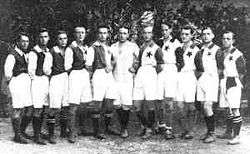Football in Slovenia
Football in Slovenia is governed by the Football Association of Slovenia (Nogometna zveza Slovenije).[1] Slovenia has participated in international football as an independent nation since 1991, when the country gained independence from SFR Yugoslavia. The Slovenia national football team has qualified for three major tournaments (UEFA Euro 2000, 2002 FIFA World Cup and 2010 FIFA World Cup).[2][3]
History
Football came to the territories that are today part of Slovenia in the late 19th century from Vienna. The first football club was founded by Germans in Ljubljana in 1900 and they were soon followed by Hungarians in Lendava (Nafta in 1903) and Germans in Celje (Athletik SK in 1906). The game soon spread among Slovenian high school' students, who founded their own teams in most Slovenian bigger cities, most notable being Hermes in Ljubljana and Jugoslavija in Gorica. In 1911 first Slovenian citizen's football club Ilirija was founded in Ljubljana, which was followed by Slovan two years later.

After the end of World War I and the creation of the Kingdom of Serbs, Croats and Slovenes, later renamed to Yugoslavia, the Yugoslav Football Association was formed, which was divided in regional subassociations. Football clubs Ilirija, Slovan and German teams from Maribor founded the Ljubljana Football Subassociation in 1920 which is the forerunner of today's Football Association of Slovenia. Ljubljana subassociation covered the territory of Slovenia and was responsible for organizing the football activities within its territory. They formed the Slovenian national team, which played its first game against France in 1921. At club level they formed a league system with several levels which started being played in 1920. The Ljubljana Subssociation first league champions played along the champions of the other Yugoslav subassociations in the Yugoslav Championship. The most successful teams were Ilirija, with 12 subassociation titles, followed by I. SSK Maribor with three titles, and, Primorje, SK Ljubljana and Železničar Maribor with two each. Stanko Tavčar was the first Slovenian footballer to play for the Yugoslav national team.[4] Most of the competitions were suspended in 1941 due to outbreak of World War II.
In SFR Yugoslavia, the majority of Slovenian clubs played in the Yugoslav football league system, while Slovenian national team continued playing as a regional amateur selection. First post-war champion Nafta competed in the 1946–47 Yugoslav First League, an achievement that was later repeated only by Olimpija Ljubljana and Maribor. Olimpija was the most successful team in the period, playing 22 seasons in Yugoslav top flight, reaching Yugoslav Cup final in 1970 and also competing in European competitions on three occasions. Most of Slovenian clubs usually played in third level Slovenian Republic Football League, where the most successful teams were Maribor and Ljubljana with five titles each. During the period 1945-1990 only a handful of Slovenian players managed to get into the Yugoslavia national football team with Branko Oblak, Srečko Katanec and Danilo Popivoda being the famous three.
After the Independence of Slovenia in 1991, national league and cup competitions were formed on the basis of old republic structures with first Slovenian PrvaLiga season therefore including 21 teams. In the same year, SR Slovenia regional selection reformed as the Slovenian national football team and played their first official match in 1992 against Estonia.
League system
| Level | Division | ||||||||
|---|---|---|---|---|---|---|---|---|---|
| 1 | Slovenian PrvaLiga 10 clubs | ||||||||
| ↓↑ 1-2 clubs | |||||||||
| 2 | Slovenian Second League 10 clubs | ||||||||
| ↓ 2 clubs | |||||||||
| ↑ 0-1 club | ↑ 0-1 club | ↑ 0-1 club | ↑ 0-1 club | ||||||
| 3 | Slovenian Third League | ||||||||
| West 10 clubs |
Center 14 clubs |
North 14 clubs |
East 14 clubs | ||||||
| ↓ 1 club | ↓ 2 clubs | ↓ 3 clubs | ↓ 2 clubs | ||||||
| ↑ 1 club | ↑ 1 club | ↑ 1 club | ↑ 1 club | ↑ 1 club | ↑ 1 club | ↑ 1 club | ↑ 1 club | ||
| Slovenian Intercommunal Leagues | |||||||||
| Koper | Nova Gorica | Kranj | Ljubljana | Celje | Maribor | Ptuj | Lendava | Murska Sobota | |
| 4 | Unified Littoral League | Upper Carniola League | Regional Ljubljana League | Golgeter League | 1. MNZ League | Superleague | 1. MNL League | 1. MNL League | |
| ↓↑ 1 club | ↓↑ 1 club | ↓↑ 1 club | ↓↑ 1 club | ↓↑ 2 clubs | |||||
| 5 | N/A | MNZ League | N/A | 2. MNZ League | 1. Class | 2. MNL League | 2. MNL League | ||
| ↓↑ 1 club | |||||||||
| 6 | N/A | N/A | 2. Class | N/A | |||||
References
- ↑ "Statistical Office of the Republic of Slovenia - FIFA World Cup 2010, South Africa". Stat.si. Retrieved 2013-12-02.
- ↑ "The Mouse That Roars: Slovenia (Not Slovakia)". The New York Times. Retrieved 2013-12-02.
- ↑ Cain, Phil (2010-06-22). "BBC News - Slovenia on brink of historic World Cup moment". Bbc.co.uk. Retrieved 2013-12-02.
- ↑ Stanko Tavčar at Reprezentacija.rs